Hyundai Ioniq 5 N 2024 review: Production-ready electric super hatch punished on road and track
Hallelujah! A truly exhilarating five-door EV
You’re looking at an optical illusion. At first glance the Hyundai Ioniq 5 N appears to be what we’ve all been waiting for: a genuine, proper, tyre-smoking electric hot hatch. But actually, if you were to park a VW Golf R next to one the German offering would look like a toy by comparison; so tiny it’d be funny. I know because I’ve seen a regular Golf and Ioniq 5 side-by-side in a car park, and I nearly sprained my neck doing a double-take.
The Ioniq 5 N, at 4.7m long, is even bigger than the regular Ioniq 5 on which it’s based and a full 20cm longer than Hyundai’s Tuscon SUV. It’s a touch wider, too, and very nearly as tall. What Hyundai’s designers have done is a very neat trick indeed. It’s a whopper, yes, but the proportions mean that in pictures it seems compact.
It looks fast, too, even in the metal. Hyundai has made some significant changes to the design inside and out with its first scorching Ioniq that complement the fairly outrageous max power figure of 641bhp, and help make this car not just look like a performance car but make it go fast. So the glossy black front bumper has a “functional mesh” and air curtains, with three active air flaps to improve the aerodynamics and cooling.
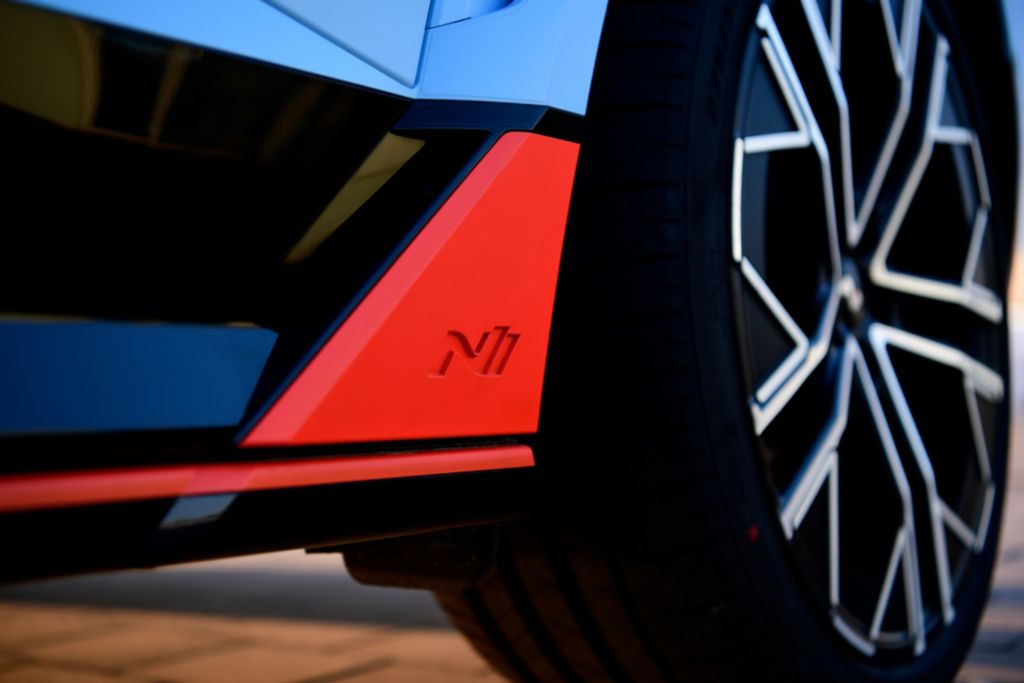
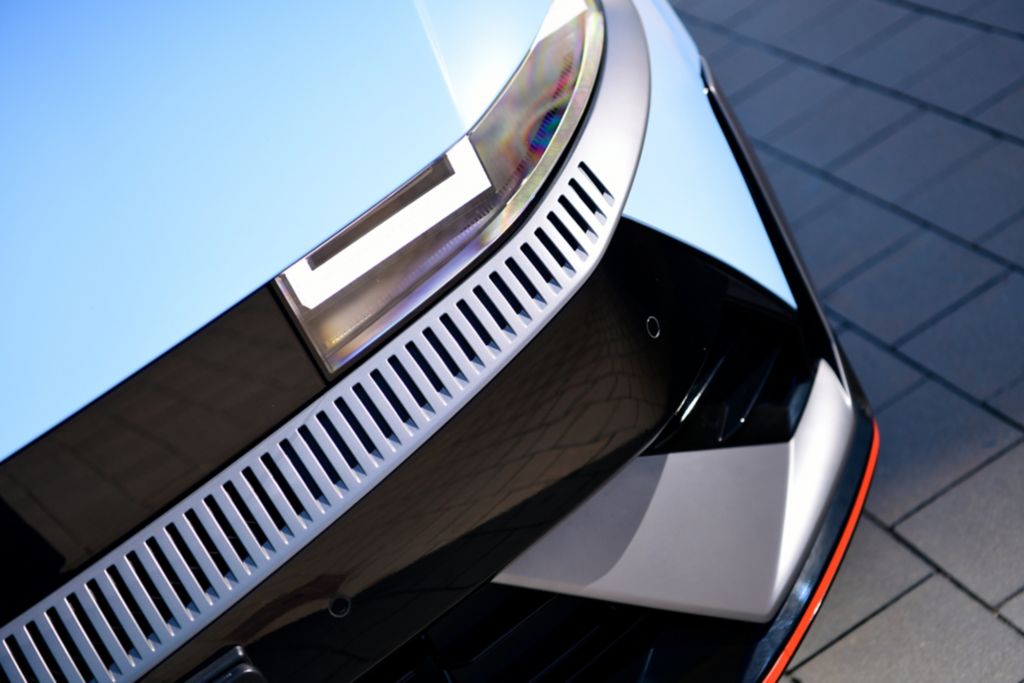
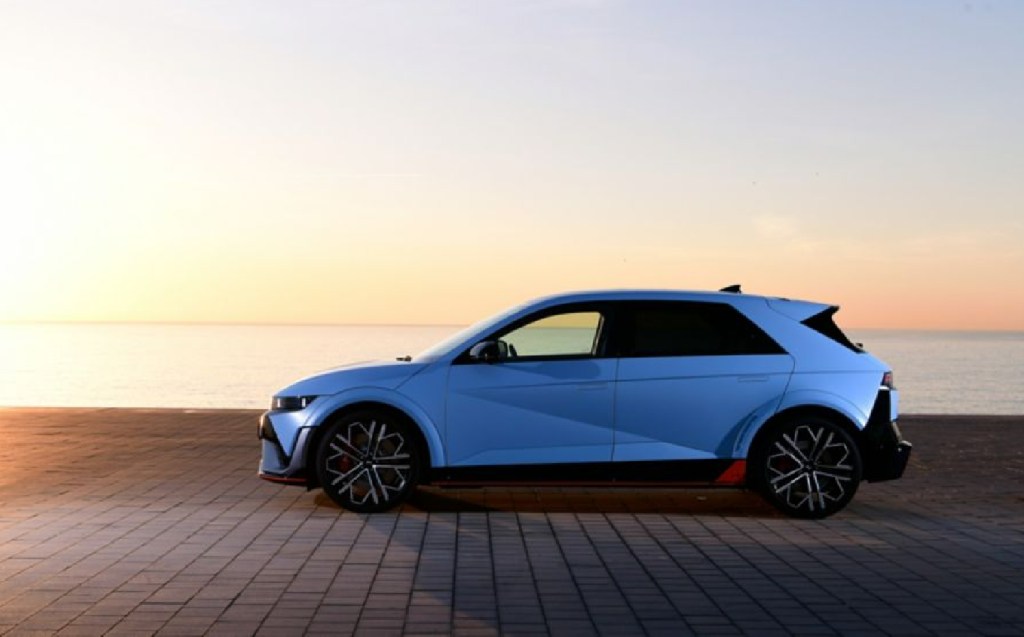
At the back there’s also a new spoiler, diffuser and other aero tweaks, and it gets unique bumpers at each end, sits lower than the regular car and has larger 21in aluminium wheels fitted with Pirelli P Zero tyres (lighter carbon rims were shown to us, too, but apparently there’s no plan to make them available in Europe just yet). Basically, it looks the business.
Open the doors and you notice the N version differs from the regular Ioniq 5 with a more serious, darker, less lounge-like cabin. The sports seats are brilliantly supportive but they’re also comfortable even for tall drivers over long distances, and they’re electrically adjustable and heated.
While the pews are designed to hold you in place around a race track, the addition of a centre console (you can step through the front of the regular car) also hints at a more driver-focused cockpit, and the chief engineer explained to me that being able to rest your knee against something helps with the familiar performance car feeling of being cocooned.
Again, Hyundai reminds us that, in true hot hatch tradition, this is a car that’s still meant to be used every day, with a wireless phone charger, USB sockets, cupholders capable of storing large bottles, and lots of other useful cubbies featuring in the redesigned centre console.
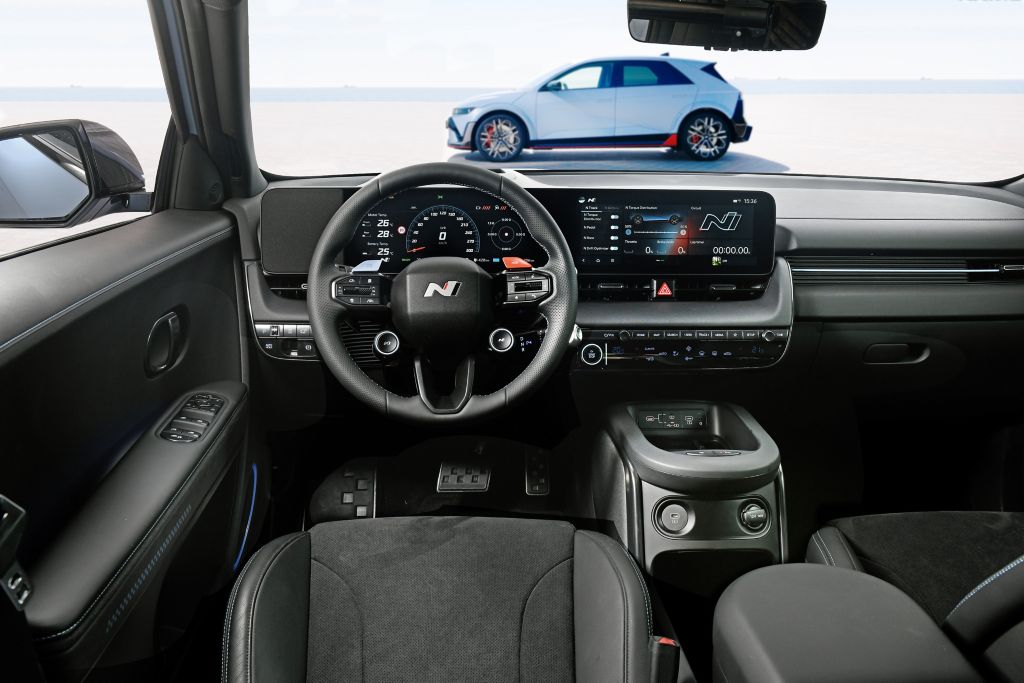
But then you look at the steering wheel. It’s like something Lewis Hamilton would hold on to, festooned with a bewildering array of buttons, most of which are for adjusting the set-up of the car.
On the upper left side of the wheel is the regular drive mode selector (Eco, Normal and Sport). On the other side is a button for N Grin Boost, which is a silly name but the effect is serious: normally, power and torque are cut to 601bhp and 546 lb ft respectively, but push “NGB” and you get the full 641bhp and 568 lb ft for 10-second bursts. Hamilton has the same sort of thing on his steering wheel, too.
Below those are two “N” buttons, which act as shortcuts to fine-tuned set-up pre-selections.
On our test car, the left activated N Performance mode, which other carmakers might call “Sport+” or “Race”, with damping and steering on the softest settings; press again for maximum suspension and steering firmness.
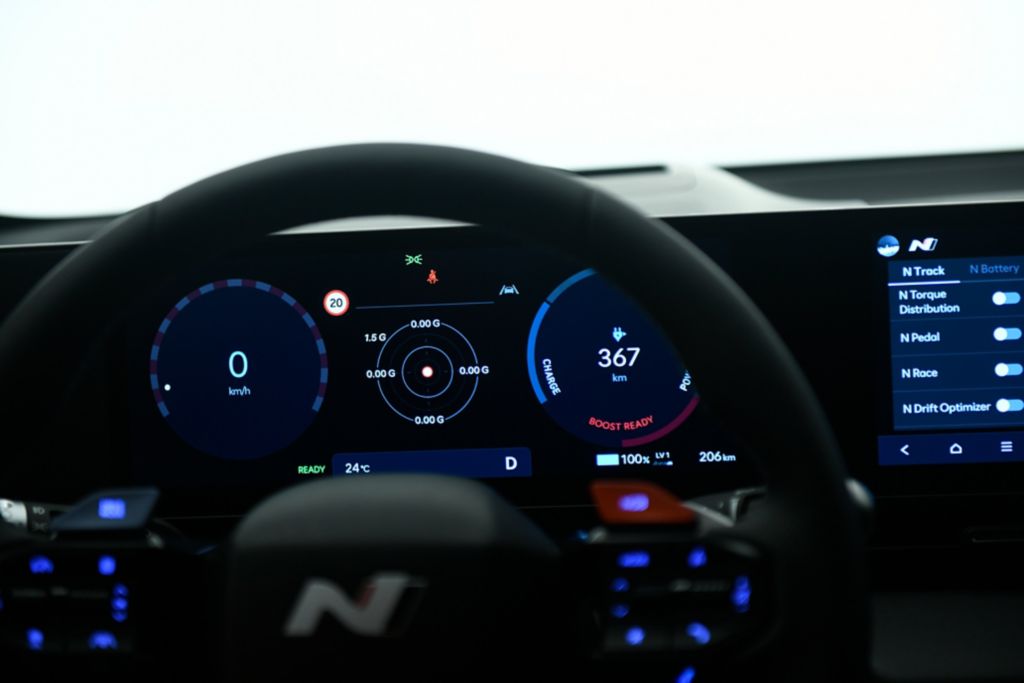
N Performance mode gives you a fake engine note. Normally I hate this sort of nonsense, and I have to say it went straight off again at first, but it did make more sense when “N e-Shift” was engaged, using the other N button (anyone getting N-oyed with the letter N yet?). This simulates real gear changes, with noise and “revs” rising to an ostensible redline, and when you then “shift up” there’s a momentary drop in torque to the electric motor, and a resulting jolt, that makes it feel as if clutch plates are being disengaged and then suddenly re-engaged, along with a related rev-change soundtrack.
When shifting down there is a fake engine blip and similar adjustments to torque that, again, pretty accurately simulate a petrol transmission.
It has nothing to do with reality, but it’s superbly executed — to the point where light throttle results in smaller jerks to those from more aggressive throttle use (and I’ve just noticed I’m using the engine-related term “throttle” here). I can tell you that, on a flowing country road and on the racetrack, it really does increase engagement.
And there’s absolutely no doubting that the Ioniq 5 N is at home on a circuit; you’re aware of the potential under your right foot right from the moment you set off, even in Normal mode. The engineers confirmed to me that you have 601bhp available in every mode except Eco, where motor output is dulled somewhat, meaning even in Normal the car bounds forward with the enthusiasm of a puppy with ADHD.
Accelerating from 0-62mph takes as little as 3.4sec, which is over a second quicker than a Mercedes-AMG A35, and the Hyundai’s twin motors will keep twisting on to a top speed of 161mph.

But in the sportier N modes the chassis is notably sharper, and incredible speed can be achieved through corners; there’s a certain confidence under braking into a sharp turn in the dry. Hyundai’s software allows you to adjust front and rear torque distribution to 11 different levels, though its electronic brain works far harder than that every millisecond to make micro-adjustments, such as creating decelerative force for the rear wheels when cornering to help with sharper turn-ins.
The adaptive damping is terrific at keeping the chassis in check, too, with the car staying relatively flat through corners for a car of this weight, with just enough lean to help the driver feel what’s going on under them.
Impressively, the electronic limited-slip differential seems to help rather than hinder acceleration out of corners. Some other carmakers haven’t managed to get this quite right, with one notably switching back to mechanical LSDs. Having 13,000 staff at its Namyang R&D centre in Korea, and a testing centre based at the Nürburgring in Germany, is clearly working for Hyundai. (Spot the “N”s, by the way.)
The grip from the Ioniq 5 Ns’s Pirelli rubber is immense, too, though with a car this heavy (2.2 tonnes), and a huge amount of electronic trickery to help mask that bulk, it’s difficult to gauge exactly where the line between traction and lack of traction is.
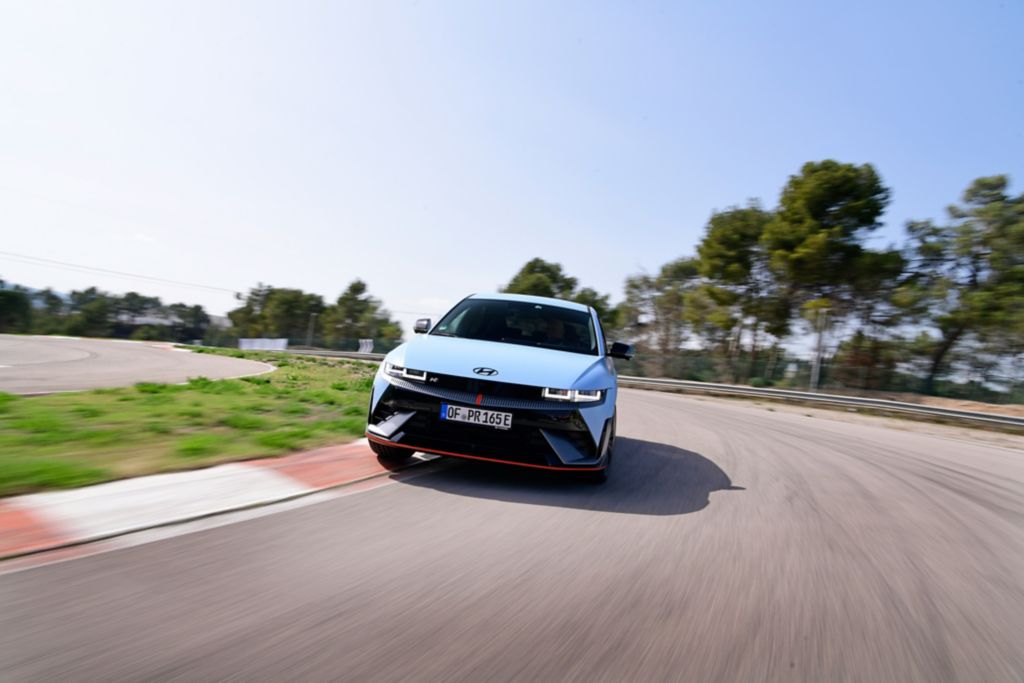
That’s why our track experience on the test was so crucial. With all of the safety aids switched off except electronic stability control, which was set to Sport, at full tilt the Ioniq 5 N cannot disguise its heft through high speed sweeping corners but weight transfer is predictable and the movement of the chassis feels natural.
I did manage to get the Ioniq 5 N slightly out of shape a number of times but I never felt out of control, and small corrections helped keep the car pointing in the right direction without scrubbing off buckets of speed.
What’s more the accelerator response is as quick as you can think, so that all-important sense of a direct link between your brain and the car via your right foot is present. And while most EVs will limit power when it senses itself getting out of shape, the Ioniq 5 N feels like it has all the power there all the time, so it scampers out of tight corners with glee rather than having a panic attack.
Crucially, on track the N Sound, or whatever it’s called, proved invaluable. For one, it gives you a much better idea of relative speed, and secondly there’s a variable amount of regenerative braking, depending on the “gear” and your speed, when downshifting, which feels much more natural when scrubbing off the mph as you’re approaching a corner.
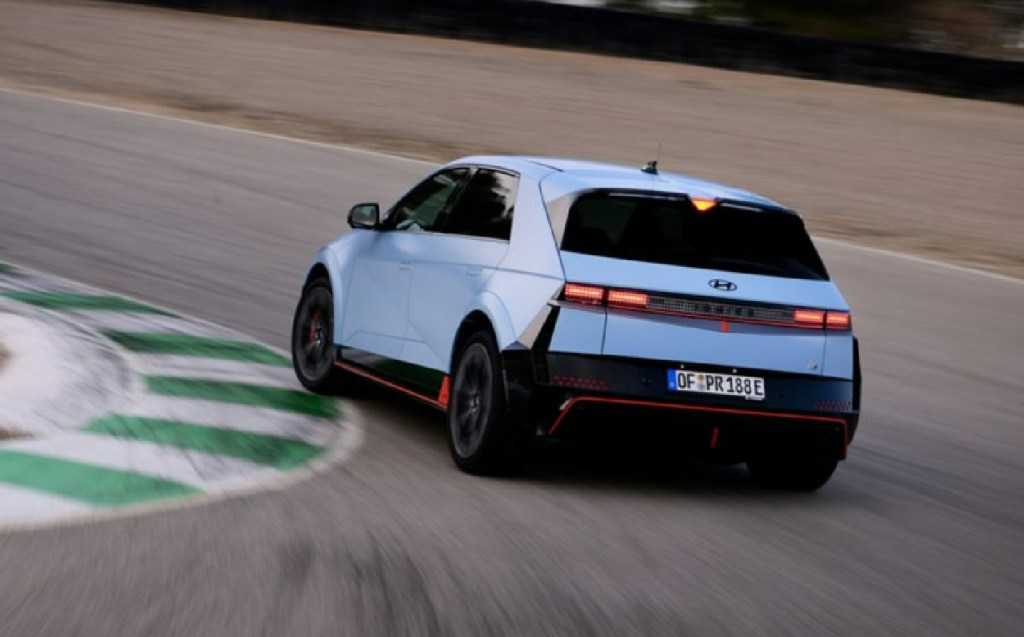
Another party trick was even more useful for finding the limits of traction… then passing them: YouTuber mode… sorry, “N Drift Optimiser” mode.
Engage this and traction control is disengaged, and at least 90 per cent of the torque is directed to the rear wheels. But some is still fed to the front, the idea being that when you add some steering lock and plant the accelerator you can easily control a powerslide (as they used to be known). We were told that, whereas a normal drift is controlled with the throttle, we were to keep our right foot planted and let the Hyundai’s electronic brain do the rest, keeping it in a sideways attitude. All we had to do, the man said, was adjust the steering lock.
Of course, this did not go well, and most of us ended up doing somewhere between a 180 and a full spin in a cloud of tyre smoke. The trick, I found on my last attempt, was to ignore that advice and plant the accelerator to initiate the slide, then lift off slightly and modulate the pedal near the 95 per cent mark. In a way, I’m glad it isn’t completely left to the car’s electronic brain, and there’s still need for a competent driver behind the wheel. But this is easily the silliest thing about the Ioniq 5 N, and you’d better have a serious budget for new Pirelli P Zero tyres.
In terms of ride quality, if you were expecting me to say it’s way too harsh for normal road use you’d be dead wrong. In fact, even in the stiffest damper setting it’s not at all unpleasant — on the roads around Barcelona, at least. The few speed humps we encountered suggested that British potholed roads may not offer such an agreeable experience, but drop the car back into Normal and the Ioniq 5 N does an admirable job of feeling poised but pleasingly pliant. This is beauty and the beast in one car, and you genuinely could drive it every day.
You might by this point want to know how far it’ll go on a charge of the battery. The official figure for the 84kWh pack (slightly larger and more efficient than the current standard Ioniq 5, though it’ll also be fitted with the new pack at the next facelift) is 278 miles. In the UK’s cool climate it’ll be less than that, while motorway speeds reduce it further, and if you’re shredding tyres it’s a fairly meaningless figure.

I can tell you that during our test, on the road I was seeing between 2.2 and 2.7 miles per kWh, which means you’d need to plug in after 185 to 227 miles. On the track, I saw the battery level drop from 99 per cent to 88 percent over 17km, which means I’d used 9kWh over 10.6 miles, at which rate you’d manage less than 100 miles before needing to charge, or around 27 laps of Silverstone.
Mind you, what does that many tours of Silverstone at ten-tenths do to a petrol engine? TVR owners might not be so brave. In theory the Ioniq 5 N’s electric motor ought to be able to repeat the experience many, many more times with little degradation.
When you do plug in, you won’t be waiting around long. Potentially, anyway. If you can find a suitably high-powered DC rapid charger then the 800v system (twice as powerful as most EVs currently) can take the battery from 10 to 80 per cent in 18 minutes. You might like to use the time spent charging to replace the tyres, too, as they’d probably be shot after 27 flat-out laps.
While we’re talking costs, the Ioniq 5 N is priced from £65,000, which is no small amount but how many other cars with this kind of performance can you get for that money? The new Porsche Macan EV isn’t quite as quick in its base form, which is comparable on paper, though is fairly similar in size and performance appeal.
They’re fishing in wildly different ponds, mind you — while Porsche owners listen to opera and mostly drive into the city, the Hyundai is the EV for people who have a penchant for neon and staying up too late at night. How does a near-silent motor change the street racing scene, I wonder?

If there’s a criticism it’s that the steering feel in Normal mode is a little inert and rubbery, especially around the centre position, though that disappears in Sport mode and above. Even the price isn’t unreasonable, in my view, given the amount of time, effort and engineering passion that has clearly gone into this car.
In the end the Hyundai Ioniq 5 N may not be traditional hot hatch size, but it most definitely feels like one to drive — well, a super hatch, really, given the extreme performance. And it’s a bloody good one, too. As with all good hot hatches it’s usable every day and practical (did I mention the 480-litre boot?), but also fun to drive on the road when you feel like it and a hoot on track. With any luck this is the breakthrough that encourages other carmakers to follow suit with fast five-door EVs that aren’t just designed to win drag races but are also fun and engaging for keen drivers, too.
Related articles
- If you were interested in this review of the Hyundai Ioniq 5 N, you might like to check out what we had to say about the Maserati Grecale Folgore, the Italian brand’s first electric SUV
- Also take a look at our review of the Porsche Taycan GTS. Is it the benchmark for electric drivers’ cars?
- And here’s our Hyundai Ioniq 6 2023 review — the electric saloon that could streamline your commute
Latest articles
- testing schedule 2
- test schedule
- F1 driver Lando Norris commissions bespoke open-top Land Rover Defender
- Citroën C3 and e-C3 2024 review: Petrol or electric, bow down before the new king of value cars
- Best-selling cars 2024: The UK’s most popular models
- Fourth-generation BMW 1 Series shows its new face with all-petrol line-up for the UK
- Cupra Tavascan 2024 review: Funky electric SUV continues Spanish brand’s EV roll
- Divine intervention? Trump-supporters’ motorhome destroyed after rolling into telegraph pole
- Extended test: 2023 Vauxhall Astra Sports Tourer GS PHEV












